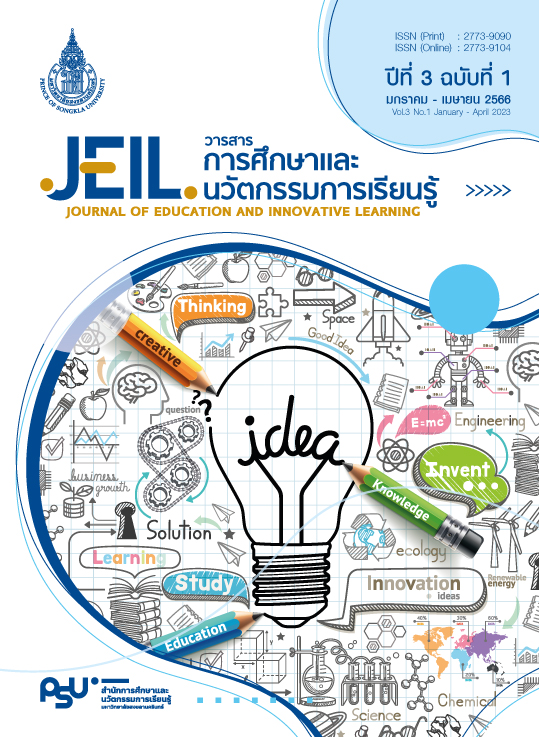การจัดการเรียนรู้ผสมผสานแบบยืดหยุ่น: กลยุทธ์การจัดการเรียนรู้ในยุคปกติถัดไป
Main Article Content
บทคัดย่อ
ในปัจจุบันความก้าวหน้าของเทคโนโลยีสารสนเทศได้มีอิทธิพลและผลักดันให้เกิดการเปลี่ยนแปลงต่อการจัดการศึกษา ประกอบกับสภาวการณ์การแพร่ระบาดของโรคติดเชื้อไวรัสโคโรนา 2019 (COVID-19) ที่ยังคงส่ง
ผลกระทบอย่างต่อเนื่องตลอดระยะเวลากว่า 2 ปี ทำให้การจัดการเรียนการสอนต้องอาศัยเทคโนโลยีการศึกษา
เข้ามาช่วยอำนวยความสะดวกและส่งเสริมการจัดการเรียนรู้ให้มีประสิทธิภาพ เหมาะสมกับบริบทของผู้เรียน และสภาพแวดล้อมการเรียนรู้ การจัดการเรียนรู้ผสมผสานแบบยืดหยุ่น มาจากคำว่า ìผสมผสานî รวมกับคำว่า ìยืดหยุ่นî เป็นการจัดการเรียนรู้ที่เน้นผู้เรียนเป็นศูนย์กลางที่จัดการเรียนรู้ในห้องเรียนปกติ ซึ่งมีการเรียนแบบเผชิญหน้า ควบคู่ไปกับการจัดการเรียนรู้แบบออนไลน์และการเรียนรู้ด้วยตนเองตามเวลาที่สะดวก ช่วยให้ผู้เรียนสามารถเลือกวิธีการเรียนรู้ได้ด้วยตนเองตามความถนัด ความสนใจ และสภาพแวดล้อมของตนเอง ผู้เรียนมีทางเลือกในการเลือกสถานที่เรียนรู้ และแหล่งการเรียนรู้ที่ตนเองชื่นชอบ ซึ่งจะช่วยเพิ่มควมยืดหยุ่นในการจัดตารางเวลา สถานที่ และวิธีการเรียนรู้ที่หลากหลาย อย่างไรก็ตามเพื่อให้กลยุทธ์การจัดการเรียนรู้รูปแบบนี้เกิดประสิทธิผลสูงสุดต่อผู้เรียน บทบาทของครูจึงเป็นส่วนสำคัญในการสร้างการมีส่วนร่วมและทางเลือกในการเรียนรู้เพื่อส่งเสริมให้ผู้เรียนบรรลุผลลัพธ์การเรียนรู้ตามที่กำหนด ซึ่งการนำเทคโนโลยีการศึกษามาบูรณาการในการจัดการเรียนการสอนในลักษณะนี้ นอกจากจะช่วยเพิ่มแรงจูงใจในการเรียนรู้ให้เกิดขึ้นในตัวผู้เรียน ยังช่วยเพิ่มโอกาสการเรียนรู้ที่มีประสิทธิภาพให้เกิดขึ้นในตัวผู้เรียนได้ทุกที่ ทุกเวลา และส่งเสริมให้เกิดความสามารถในการเรียนรู้ด้วยตนเองอีกด้วย
Article Details

อนุญาตภายใต้เงื่อนไข Creative Commons Attribution-NonCommercial-NoDerivatives 4.0 International License.
เนื้อหาและข้อมูลในบทความที่ตีพิมพ์ในวารสารการศึกษาและนวัตกรรมการเรียนรู้ ถือเป็นข้อคิดเห็นและความรับผิดชอบของผู้เขียน ซึ่งกองบรรณาธิการวารสาร ไม่จำเป็นต้องเห็นด้วยหรือร่วมรับผิดชอบใด ๆ และไม่สงวนสิทธิ์การคัดลอกบทความเพื่อใช้ประโยชน์ทางวิชาการ แต่ให้อ้างอิงข้อมูลแสดงที่มาของบทความทุกครั้งที่นำไปใช้ประโยชน์
เอกสารอ้างอิง
Bamroongcheep, U. (2014). HyFlex learning: instructional technology in 21st century. Journal of Education Burapha University, 15(1), 15-29. [in Thai]
Barclay, A., Ceccolini, K., Clarke, K., Domonchuk, N., Shapiro, S., & Singh, J., … Arseneau, C. (n.d.). HyFlex course design and teaching strategies. Retrieved from https://ecampusontario.pressbooks.pub/hyflexcoursedesignandteachingstrategies/chapter/unit-1-what-is-hyflex/
Beatty, B. J. (2022). Hybrid-flexible course design: implementing student-directed hybrid classes. Retrieved from https://edtechbooks.org/pdfs/print/hyflex/_hyflex.pdf
Columbia University. (n.d.). Hybrid/HyFlex teaching & learning. Retrieved from https://ctl.columbia.edu/resources-and-technology/teaching-with-technology/teaching-online/hyflex/
Equitable Education Fund. (2021). Lessons learned from China to Thailand: when the resilience is the heart of learning in COVID-19. Retrieved from. https://www.eef.or.th/reviewing-the-quality-and-resilience-of-education-chinese-experience-on-flexible-learning-in-the-time-of-covid-19/ [in Thai]
Kaewrattanapat, N. (2022). What is HyFlex learning?. Retrieved from https://elsci.ssru.ac.th/nutthapat_ke/mod/forum/discuss.php?d=15 [in Thai]
Rodniyom, A. (2021). Education technology and online teaching and learning management in the New Era. Journal of Social Science and Buddhistic Anthropology, 6(9), 123-133. [in Thai]
Sakulprahmne, S., & Prasertsaruay, S. (2015). Development of flexible learning model for the undergraduate students. Journal of Humanities and Social Sciences Valaya Alongkorn, 10(1), 27-35. [in Thai]


